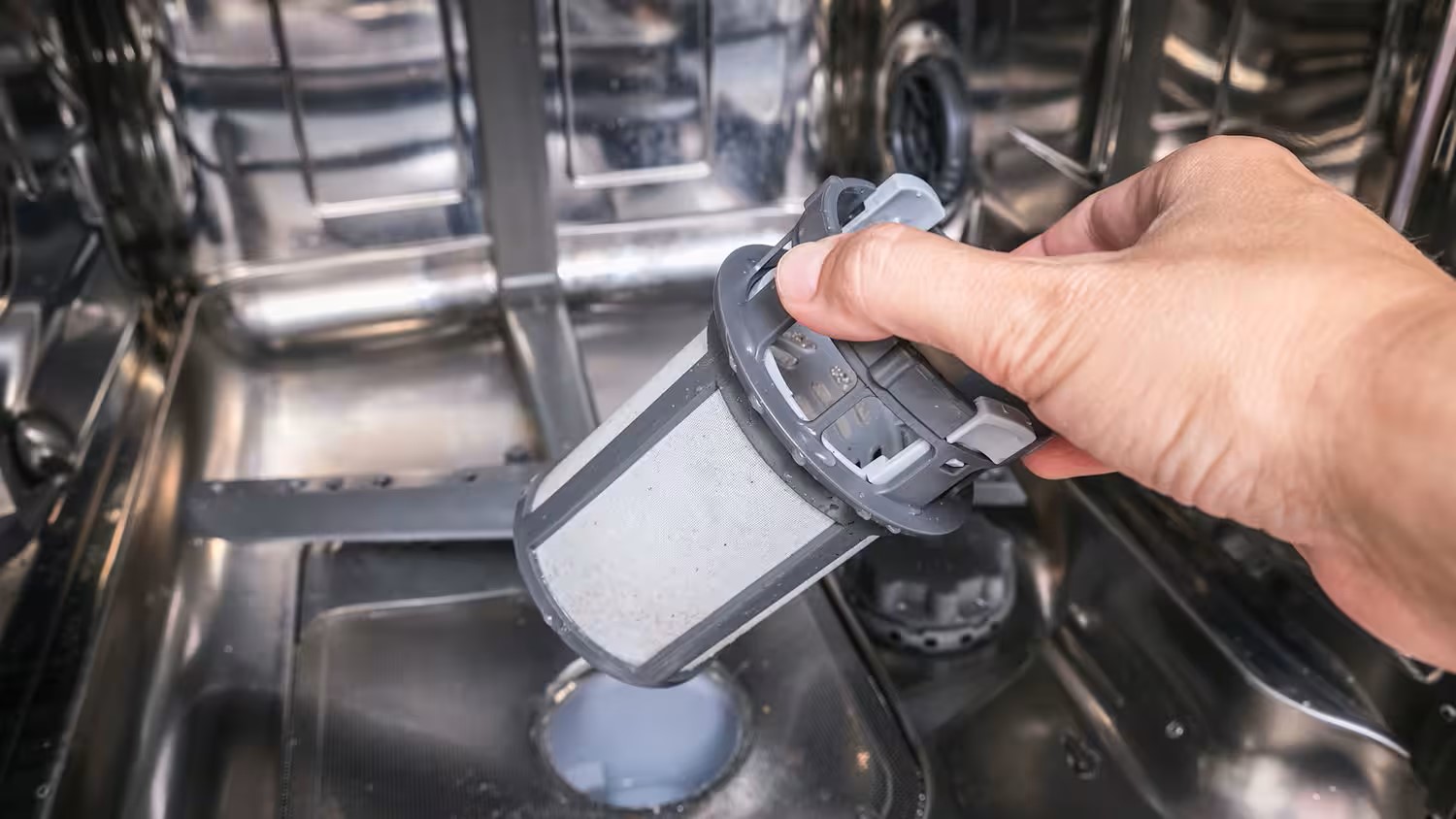To force your GE dishwasher to drain, press the “Start/Reset” button, or toggle the power to initiate a forced drain cycle. Ensure the appliance is free from clogs and the drain hose is properly positioned.
Experiencing a dishwasher that won’t drain can be painful, but with a GE model, addressing the issue can be straightforward. A properly functioning dishwasher is a must to maintain a smooth kitchen routine and hygiene standards. It’s important to act quickly to prevent water from becoming stagnant and creating odors or leading to potential water damage.
It is important to know the basics of your GE dishwasher’s operation is vital for troubleshooting common problems, like drainage issues. Before calling in a professional, there are simple steps every homeowner can take to potentially resolve the issue themselves.
These steps include checking for food particles and debris that might be blocking the filter or ensuring that the drain hose is not kinked or improperly installed. Regular maintenance and awareness can prevent future drainage problems and extend the life of your appliance.
Table of Contents
Identify The Need For A Forced Drain For GE Dishwasher
Is your GE dishwasher stuck full of water? This could mean the drain needs a manual nudge. Learning to identify when your dishwasher requires a forced drain is important. It can prevent further damage. Your trusted kitchen appliance needs a quick fix. Let’s guide you through spotting a drain issue and safely fixing it.
Signs Of A Malfunctioning Drain
Observing your dishwasher for telltale signs is essential. Look for clues. Some common indicators include:
- Water pooling at the bottom post-cycle.
- An unusually foul smell which suggests standing water.
- Dishes not clean due to inadequate drainage.
- Unusual noises during the drain cycle.
Safety Precautions Before Fixing
Before tinkering with your dishwasher, prioritizing safety is vital. Take these precautionary steps:
- Turn off the power to the dishwasher.
- Wear protective gloves.
- Ensure the dishwasher is empty.
- Keep tools and pieces organized.
Initial Steps To Encourage Draining
A GE dishwasher that won’t drain can be a hassle. Quick initial steps can sometimes solve the problem. Follow these simple troubleshooting methods before calling a professional. These steps may save time and cost.
Power Cycling The Dishwasher
Resetting your dishwasher could kick-start the drain cycle. Here’s what to do:
- Turn off the appliance at the wall or unplug it.
- Wait for at least one minute.
- Reconnect the power to reset the dishwasher.
- Run a drain cycle to see if the issue resolves.
Check The Garbage Disposal Connection
Dishwashers usually connect to garbage disposals. A clog can stop your dishwasher from draining:
- Ensure the disposal is clear.
- Run the disposal for at least 30 seconds to clear debris.
- Check the knockout plug. Remove it if it’s still intact.
Manual Drainage Methods
When a GE dishwasher won’t drain, manual methods can save the day. Before attempting these fixes, unplug your dishwasher or turn off its circuit breaker. By doing this, you ensure safety during the drainage process. Below, we’ll explore two manual methods to tackle water that won’t drain.
Use A Sponge To Remove Water
A large, absorbent sponge becomes a handy tool in this situation. First, open the dishwasher and remove the bottom dish rack to access the standing water. Then, using the sponge, soak up the water and wring it out into a bucket or sink. Repeat this process until you remove most of the water.
Siphoning Water Out Of GE Dishwasher
Siphoning is a practical method if sponging is too slow. You’ll need a length of tubing to begin. Place one end of the tubing into the water at the bottom of the dishwasher. Suck the other end of the tube to start the water flow, making sure to keep the end in your mouth lower than the water level in the dishwasher. Let the water run until empty. Be careful not to ingest any water during this process.

Credit: appliancedoctorofwestmichigan.com
Remove Blockage From The Drain Path
Don’t let standing water throw a wrench in your routine. Often, the culprit could be a simple blockage in the drain path. To restore your dishwasher to its peak performance, start by addressing common areas where clogs can occur. Roll up your sleeves and follow these straightforward steps to ensure a free-flowing drain.
Clean Dishwasher Filter
Keep the heart of your dishwasher clean. The filter traps food particles and debris. If left unattended, it can block water from draining. Here’s a quick guide to cleaning your dishwasher filter:
- Locate the filter: Typically, it’s at the bottom of the dishwasher.
- Twist to remove: Turn the filter counterclockwise to unlock it.
- Rinse with water: Use your sink to wash away gunk.
- Reinstall the filter: Place it back and twist to secure.
Clean filters help water flow easily. Perform this task regularly for best results.
Inspect The Drain Hose For Clogs
The drain hose is a typical spot for clogs. Let’s check for any blockages:
- Disconnect power: Safety first. Unplug the dishwasher or turn off the circuit breaker.
- Locate the drain hose: It’s usually under the sink or behind the dishwasher.
- Check for kinks: Ensure the hose isn’t bent out of shape.
- Clear obstructions: Feel for clogs and gently straighten any kinks.
If the hose is clear yet issues persist, a deeper clog might exist. Consider detaching the hose. Flush it with water or use a plumber’s snake.
Advanced Solutions For GE Dishwasher Force Drain
Encountering a stubborn GE dishwasher that refuses to drain can be disgusting. When basic fixing method doesn’t do the trick, it’s time to explore advanced solutions. From resetting the system to getting professional aid, we dive into how to resolve this issue efficiently.
Reset Dishwasher’s System
Resetting your GE dishwasher is often a quick fix. This can resolve glitches causing drainage problems. Follow these steps:
- Disconnect power by unplugging or turning off the circuit breaker.
- Wait a full minute to ensure system reset.
- Restore power to the dishwasher.
- Run a short cycle to test the drain function.
If the dishwasher still doesn’t drain, check the manual for a dedicated reset code or button combination specific to your model.
Seeking Professional Help
Some issues need expert hands. Complex problems such as clogged pumps or faulty sensors might be the culprits. Here’s what you can do:
- Identify a licensed technician with good reviews.
- Provide the model number and detailed description of the issue.
- Schedule an appointment for a thorough examination.
Professional assistance ensures a precise diagnosis and proper repair, safeguarding your dishwasher’s longevity and performance.

Credit: storables.com
Preventative Maintenance Tips For Future Drain Issue
Regular upkeep helps your GE dishwasher stay in peak condition. Simple tasks prevent drainage issues. Follow these tips for a well-maintained appliance. Your dishwasher will thank you with efficient service and longevity.
Routine Cleaning For Optimal Performance
Keeping your dishwasher clean is essential. It’s not just about wiping the exterior. A clean interior reduces the risk of clogs.
- Run an empty cycle with vinegar once a month.
- Clean the filters and traps regularly. Remove and rinse them under running water.
- Wipe down the seals and door edges. Use a damp cloth to remove residue.
Periodic Inspections To Avoid Clogs
Avoid sudden drainage problems by inspecting your dishwasher periodically. Look at the key areas where clogs might form.
Inspection Area | Action |
|---|---|
Drain hose | Ensure it’s not kinked or blocked. |
Spray arms | Check for food particles blocking the holes. |
Bottom of dishwasher | Remove any debris that might block the drain. |
Employ these tips for a hassle-free dishwasher experience. Simple routines can save you from future headaches.
FAQ
Why Won’t My GE Dishwasher Drain?
It could be caused by clogged filters, a blocked drain hose, or a malfunctioning drain pump. Check and clean filters and hoses. If issues persist, a professional may need to inspect the drain pump.
How Do I Manually Drain A GE Dishwasher?
First, turn off the power to your dishwasher. Then, remove the bottom rack and use a sponge or cup to remove the standing water. Locate the drain and clean away any debris that might be causing the blockage.
Where Is The GE Dishwasher Drain Button?
GE dishwashers do not typically have a specific drain button. To initiate draining, you may need to start a cycle and then cancel it. The cancellation should activate the dishwasher’s automatic drain cycle.
Can I Force My GE Dishwasher To Drain?
Yes, you can force it to drain by starting a cycle and pressing the ‘Start/Reset’ button to cancel and initiate the drain. Ensure that the door is latched properly for the process to work.
Bottom Line
With the steps discussed on how to force drain a GE dishwasher, you’re equipped to tackle the issue head-on. Remember to keep safety first, check for clogs, and perform routine maintenance. Your dishwasher should be back in top shape, ready to easily tackle the next round of dirty dishes.



